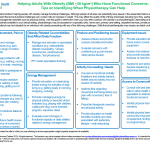Is your wellness business doing everything it can to deliver its products and services reliably?
There’s an old fable about a Zen student who approaches a master, seeking enlightenment. The master says four words: “Chop wood, carry water.” The student goes off and dutifully obeys, but feels no more enlightened when he returns, and repeats the question only to get the same answer. After several more visits, in frustration, he exclaims to the master, “I’ve chopped more wood and carried more water than I’ve ever wanted to, and I’m no more enlightened than at the start!”
“That is true,” says the master. “But you must still chop wood and carry water or there will be no fire and nothing to drink.”
The moral of the story is that sometimes, you just have to stop and do the necessary things.
When you do, sometimes amazing things happen.
What does consistency (or its absence) mean to customers?
Little things matter; some more than others. Like front desk personnel making eye contact, fixing broken equipment quickly, or proactively informing members about changes to programs, hours, or billing. But how much does each little thing matter?
If you hand everyone free bottled water (perhaps even private-labeled) when they walk in, will they feel more appreciated and slightly more loyal?
If you stopped putting out fresh towels tomorrow, would no one notice? Or would customers feel like you’d just stopped caring? What would you feel if you were a customer and your business stopped doing it? How would customers feel if you only put fresh towels out when you felt like it? Would they start bringing their own? Would they care?
It depends.
Free bottled water can’t transform a mediocre customer experience. You must know where to focus your effort before you strive for consistency.
What does consistency mean to your business?
Delivering the same level of quality every day isn’t fun. In fact, it can be excruciatingly boring.
But customers hate inconsistency. They hate not knowing what to expect. When they know they can count on your wellness business, you’ve increased the odds that they’ll overlook the occasional glitch. If you provide an erratic experience, every little annoyance is another nail in the coffin.
My gym does a great job of providing plenty of lap lanes, keeping the chemical levels right, the water temp the same, removing slip hazards, and keeping a lifeguard on duty. It makes it much easier for me to ignore the screeches of the extremely annoying water aerobics instructor in the warm water pool to my right.
Set a goal that matters to customers — for example, a commitment to making sure every piece of cardio equipment will consistently work. Then define what consistently reaching that goal means.
Let’s say your goal for cardio equipment uptime is that no piece will be out of order for more than four hours. That’s a heckuva goal! Most health clubs measure acceptable levels of equipment downtime in days, even weeks. Do customers think days and weeks of downtime are acceptable? Of course not.
Consistency leads to quality and efficiency improvements
Now, ask yourself what has to happen to meet that cardio equipment uptime goal.
It may mean a much more aggressive preventive maintenance schedule, or proactively replacing equipment after a certain number of duty cycles. It might mean keeping a small inventory of certain parts, and getting one of your own staff members trained on how to replace those parts, so you’re not as reliant on a third-party repair service.
Or maybe it means paying a premium price so that your service reports get addressed first by that repair company.
Focus on the boring parts of your business
Paying close attention to something you don’t particularly enjoy can lead to remarkable insight. Recently, I spent the better part of a week of swim training focusing only on how my hands moved out of the water on each stroke — the angle, the drag, the height, the timing, where my other hand was… everything. A week later, I noticed I had shaved 30 minutes off my 4000 meter time.
Insight doesn’t come from a quick glance once a month at your financials, or your membership sales, or your SEO metrics, or your weight loss program enrollment.
It only comes when you invest time on an ongoing basis to measure and improve something in your business.
Pick anything necessary to your business and do it consistently. Especially if the task is part of a new or changed process, repetition improves the chances that the changes will endure.
One of our clients recently assigned important new responsibilities to their member services director. The person currently in the job didn’t have all the skills. But his boss committed to twice-weekly one-on-one coaching meetings, and it’s actually turning out really well. The biggest reason: that commitment to one-on-one meetings. They’ve been tempted to cancel them when things are super-busy, but so far they’ve both made every single one. Not exciting, but essential.
Change isn’t always good
If things aren’t going as expected, it’s very tempting to drop what you’re doing like a hot potato and latch onto something new. We see this again and again, mostly with sales and marketing efforts.
Often, what needs changing isn’t what you’re doing, but how you’re doing it. Should you use email marketing, even though your open rate is zero? Of course. You just need to do a better job of it.
If your operational focus is consistent with your business goals but you’re still not getting the results you expected, the key probably isn’t to immediately switch gears. You probably need to dig deeper into exactly what you’re doing, spend more time analyzing the data, and invest in finding ways to do a better job of the stuff that’s falling short.
In other words, chop wood, carry water.



